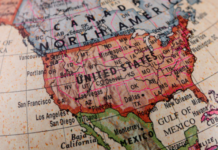
Published in Real Clear Policy
Following the World Economic Forum’s wrap up of its recent annual meeting in Davos, Switzerland, U.S. policymakers should return with strategies for strengthening America’s economic growth and augmenting our global competitiveness. A pessimism for global economic growth was a pervasive mood among CEOs at Davos, and the U.S. can demonstrate leadership by adopting some critical policy prescriptions to accelerate growth. They should begin with lowering America’s corporate tax rate – currently the highest among the OECD and BRIC countries at 39 percent (combined federal and state) – and reducing the excessive regulations that hamper innovation, stifle productivity, and exhaust capital resources. America’s global standing in competitiveness could diminish, unless policymakers seriously commit to comprehensive tax reform that refrains from picking winners and losers in today’s economy.
High taxes and excessive regulation serve as America’s twin hurdles to capital formation, the essential expenditure necessary to preserve and increase the stock of our nation’s wealth. Entrepreneurship and commerce have suffered in recent years, but so too, has American competitiveness. This should be unsurprising as U.S. tax laws contain an inherent bias against saving, investment, and work effort. Our high tax rates actually reduce after-tax returns to work effort, thus decreasing both the amount of labor supplied and also productivity-enhancing investment.
Economists agree that taxes should be designed so that the relative prices of work effort and leisure, and of consumption and saving – in other words, investment – are not disturbed after their imposition. One way to increase rates of capital formation in the U.S. is to reduce the existing tax bias against saving and investment. The development of these “neutral” tax policies should be a major goal of comprehensive tax reform so that all industries are treated equally. Such policies would not differentially alter the prices of the necessary ingredients of production: work effort, saving, and investment.
In addition to our growth-retarding tax structure, the rapid expansion of government regulation in recent years has also resulted in high compliance costs to firms, ultimately impacting their competitiveness. For example, as firms devote greater portions of their resources to meeting regulatory requirements, new product development is delayed, increasing the final cost of bringing a new product to the market. If a firm is already operating efficiently, the increased costs caused by these government regulations may well result in either lower profit margins, which result in even fewer resources being devoted to production innovation, or higher prices to the public.
When we look at the data, we see how federal tax, spending, and regulatory policies undermine capital formation and diminish economic growth by altering the level and distribution of capital goods. In fact, such policies have interfered with the necessary expansion of capital formation in recent years.
America’s domestic capital formation has declined over time, and in marked contrast to our top ten trading partners. We now lag behind all countries except the U.K. in gross fixed capital formation as a percentage of GDP for the period 2007-2014. This record reflects poorly on America’s ability to replace and expand the capital stock with new and innovative equipment, which is essential to our ability to improve the productivity of our work force.
In its annual Global Competitiveness Report, the World Economic Forum ranked the U.S. 51 out of 140 countries based on its government-imposed regulatory burden. And, a 2012 study conducted by Nicole V. Crain and W. Mark Crain determined that the average U.S. company paid $9,991 per employee per year to comply with federal regulations, with the total annual burden estimated to be over $2 trillion.
Our elected officials are fortunately paying attention to these tax and regulatory burdens. Presidential candidates and lawmakers alike have advocated for comprehensive tax reform to be on this year’s legislative agenda. President Obama’s 2015 Economic Report identified many of the problems associated with the current business tax system and set reform goals to, “improve the quantity and quality of U.S. investment and thus productivity and output.” And in his recent State of the Union address, he emphasized the need to fix our regulatory system.
America’s economic engine remains the envy of the world; yet, we have the power to innovate even more advanced technologies, and produce more goods, faster, and at a lesser expenditure. Our stagnant growth, on account of an outdated tax structure, is entirely of our own making. So, too, will be the remedy: lower, fairer, tax system that treats all investments the same coupled with an updated, regulations based on cost/benefit analysis.






